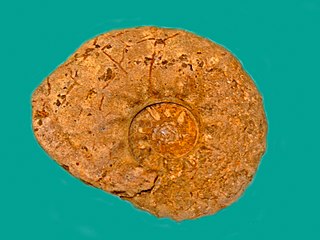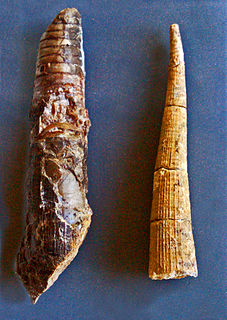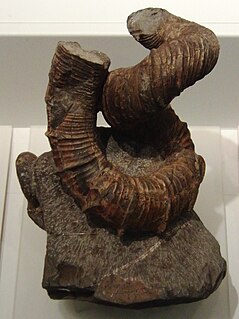Related Research Articles

Goniatites is a genus of extinct cephalopods belonging to the family Goniatitidae, included in the superfamily Goniatitaceae. Hibernicoceras and Hypergoniatites are among related genera.
Joseph John Sepkoski Jr. was a University of Chicago paleontologist. Sepkoski studied the fossil record and the diversity of life on Earth. Sepkoski and David Raup contributed to the knowledge of extinction events. They suggested that the extinction of dinosaurs 66 mya was part of a cycle of mass extinctions that may have occurred every 26 million years.
Aegoceras is an evolutionary wound ammonite, with wide spaced ribs, from the Early Jurassic (England) included in the Liparoceratidae and superfamily Eoderoceratidae. Related genera are Leparoceras and Beaniceras.
Anahamulina is an extinct ammonoid cephalopod genus from the Lower Cretaceous. Named by Hyatt, 1900, Anahamulina is included in the family Ptychoceratidae, which is part of the Turrilitaceae.

Barroisiceras is an acanthoceratacean ammonite from the Upper Cretaceous, Coniacian, included in the family Collignoniceratidae.
Benueites is an extinct ammonoid cephalopod genus from the Late Cretaceous (Turonian), named by Revment, 1954, included in the family Acanthoceratidae, superfamily Acanthoceratoidea.

Zaniolepis is a genus of scorpaeniform fish native to the eastern Pacific Ocean. Z. frenata that was a source of food to the Native American inhabitants of San Nicolas Island off the coast of southern California, United States during the Middle Holocene.

Normannites is a strongly ribbed evolute Middle Jurassic genus of ammonite included in the stephanoceratoid family Stephanoceratidae.

Hyperlioceras is an extinct genus of cephalopod included in the ammonitid family Graphoceratidae that lived during the Bajocian stage of the Middle Jurassic. The type species is Hyperlioceras discites

Nostoceras is an extinct genus of ammonites. The etymology of the name Nostoceras comes from "nostos" meaning return and "ceros" meaning horn, named as such by Alpheus Hyatt because it bends back on itself.

Rhadinichthys is an extinct genus of prehistoric bony fish.
Crioceras is an extinct cephalopod genus belonging to the subclass Ammonoidea and included in the family Crioceratidae of the ammonitid superfamily Ancylocerataceae. Crioceras is considered by some to be a junior synonym of Crioceratites

Kionoceras is an extinct nautiloid cephalopod genus included in the orthocerid family Kionoceratidae with scattered worldwide distribution from the Middle Ordovician to the Lower Permian. Kionoceratids are orthocerids with prominent longitudinal ornamentation on their shells, sometimes augmented by secondary transverse ornamentation. Orthocerids are, of course, prehistoric nautiloides with generally straight and elongate shells, mostly with central or subcentral siphuncles.

Eubostrychoceras is a genus of helically wound, corkscrew form, heteromorph ammonite which lived during the Upper Cretaceous. The genus is included in the ancycleratid family Nostoceratidae.

Macroscaphites is an extinct cephalopod genus included in the Ammonoidea that lived during the Barremian and Aptian stages of the Early Cretaceous. Its fossils have been found throughout most of Europe and North Africa.

Belemnites is a genus of an extinct group of cephalopods belonging to the order Belemnitida. These cephalopods existed in the Early Jurassic period from the Hettangian age to the Toarcian age (175.6–183.0). They were fast-moving nektonic carnivores.

Metoioceras is an extinct genus of cephalopod belonging to the Ammonite subclass which lived during the Cenomanian.
Melchiorites is a desmoceratid ammonite genus included in the subfamily Puzosiinae. Member species are characterized by an essentially evolute shell in which the early whorls are smooth, with sinuous radial or oblique constrictions but in which later whorls have feeble intermediate ribs on the outer part of the sides and venter.
Daxatina is a fossil ammonoid cephalopod included in the trachyceratid family of the order Ceratitida that lived during the middle of the Triassic.

Dufrenoyia is an extinct genus of Cretaceous ammonites included in the family Parahoplitidae. These fast-moving nektonic carnivores lived in the Cretaceous period. The type species of the genus is Ammonites dufrenoyi.
References
- Notes
- ↑ Sepkoski, Jack (2002). "Sepkoski's Online Genus Database" . Retrieved 2014-05-28.
- 1 2 "Paleobiology Database - Olenekoceras" . Retrieved 17 December 2021.
- Bibliography
- W.J. Arkell, et al., 1957. Mesozoic Ammonoidea; Treatise on Invertebrate Paleontology, Part L. Geological Society of America and University of Kansas Press.